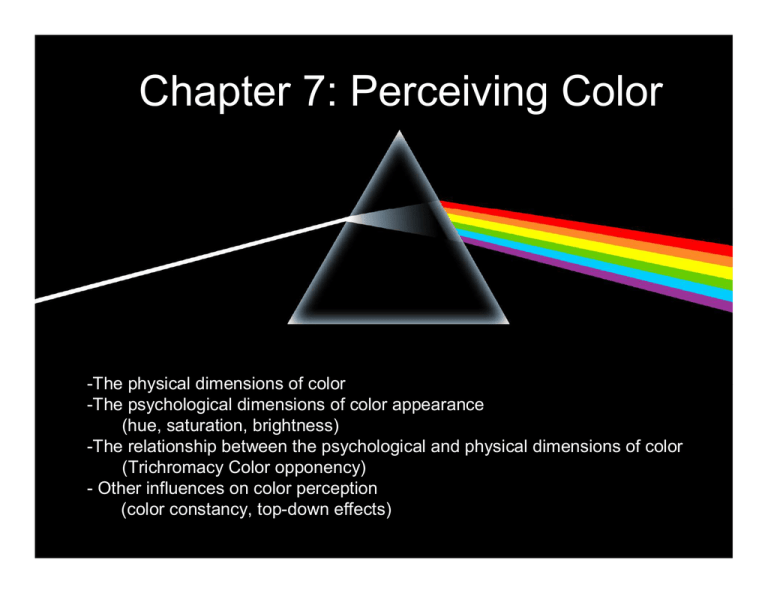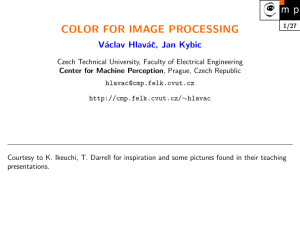Chapter 7: Perceiving Color
advertisement

Chapter 7: Perceiving Color -The physical dimensions of color -The psychological dimensions of color appearance (hue, saturation, brightness) -The relationship between the psychological and physical dimensions of color (Trichromacy Color opponency) - Other influences on color perception (color constancy, top-down effects) Sir Isaac Newton Newton’s Prism Experiment (1704) White light is composed of multiple colors Light Monochromatic light: one wavelength (like a laser) Physical parameters for monochromatic light 1. Wavelength 2. Intensity Heterochromatic light: many wavelengths (normal light sources) For heterochromatic light The spectral composition gives the intensity at each wavelength Monochromatic light Heterochromatic light Spectral composition of two common (heterochromatic) illuminants The spectral components of light entering the eye is the product of the illuminant and the surface reflectance of objects. Reflectance of some common surfaces and pigments 350 400 450 500 550 600 650 700 750 800 Surface reflectance of some common objects 350 400 450 500 550 600 650 700 750 800 Spectral composition of light entering the eye after being reflected from a surface = Spectral composition of the illuminant X Reflectance of the surface a. bright orange b. dark/dim orange c. black d. dark/dim blue Relative amount of light Consider a ripe orange illuminated with a bright monochromatic blue (420 nm) light. What color will the banana appear to be? Blue (monochromatic) Wavelength Spectral composition of light entering the eye after being reflected from a surface = Relative amount of light Spectral composition of the illuminant X White light Blue Orange (monochromatic) (monochromatic) Wavelength Reflectance of the surface Color Vision -The physical dimensions of color -The psychological dimensions of color appearance (hue, saturation, brightness) -The relationship between the psychological and physical dimensions of color (Trichromacy Color Opponency) - Other influences on color perception (color constancy, top-down effects) Color • Physical dimensions of color Spectral composition light source X reflectance • Psychological dimensions of color 1. Hue (e.g., red, blue, green) 2. Saturation (e.g., pastel, ‘deep & rich’) 3. Brightness (e.g., dim, bright) Psychological dimensions of color Newton noticed that the color spectrum could be represented in a circle. Newton, 1703 Psychological dimensions of color 1. hue Psychological dimensions of color 2. saturation Psychological dimensions of color 3. brightness Psychological dimensions of color The color solid. Graphics programs allow you to pick colors by hue, saturation and brightness from a color circle. How do we get from the physical properties of light: 350 400 450 500 550 600 650 700 To the psychological dimensions of color? 750 800 Hue: peak (center) of spectral distribution 400 500 600 700 400 500 600 700 400 500 600 700 Saturation: spread (variance) of spectral distribution 400 500 600 700 400 500 600 700 400 500 600 700 Brightness: height of spectral distribution 400 500 600 700 400 500 600 700 400 500 600 700 These rules of hue, saturation and brightness are useful for simple (univariate) spectral distributions: 400 500 600 700 Bright, saturated blue 400 500 600 700 400 Bright, partially desaturated red (pink) 500 600 Dark, desaturated green But what about any arbitrary distribution? 400 500 600 random ? 700 400 500 600 700 two primary colors + =? 700 three primary colors + + =? Color mixtures Subtractive mixtures Occur with paints (pigments) and filters For pigments: In the mixture, the only wavelengths reflected by the mixture are those that are reflected by all components in the mixture. White light Cyan reflected White light Yellow reflected + Cyan paint = Yellow paint White light Subtractive mixtures For filters: wavelengths in the ‘mixture’ are those that are passed by every filter in use. Additive mixtures The spectrum above is created on an RGB computer monitor by additive mixing You can create additive mixtures by putting pixels very close together That’s how TVs and computer monitors work. And stadium scoreboards Georges Seurat, the French Pointillist Painter knew about this! Georges Seurat, The Channel of Gravelines (1890) Pointillism painters mixed colors additively rather than subtractively! Closeup, Georges Seurat, The Channel of Gravelines (1890) TV’s with three phosphors work because almost any color can be generated by adding different amounts of the three primary colors. TV’s with three colors (phosphors) work because almost any color can be generated by adding different amounts of the three primary colors. Absorption (%) Why? Because we have three types of photoreceptors. 400 450 500 550 600 650 Wavelength (nm) 700 750 Physiology of color vision The normal retina contains three kinds of cones (S, M and L), each maximally sensitive to a different part of the spectrum. Hofer, H. et al. J. Neurosci. 2005;25:9669-9679 Trichromatic theory of color vision Young-Helmholtz Theory (1802,1852). Our ability to distinguish between different wavelengths depends on the operation of three different kinds of cone receptors, each with a unique spectral sensitivity. Each wavelength of light produces a unique pattern of activation in the three cone mechanisms. Perceived color is based on the relative amount of activity—the pattern of activity—in the three cone mechanisms. The Principal of Univariance the absorption of a photon of light by a cone produces the same effect no matter what the wavelength. A given cone system will respond the same to a dim light near peak wavelength as a bright light away from the peak. For example, the M cones will respond equally to a dim green light as a bright red light. As far as the M cones are concerned, these lights look the same. A given light will excite the L, M, and S cones differently 400 300 500 400 S 600 500 600 M 400 700 700 L 800 300 500 400 S 600 500 600 M 700 700 L 400 800 300 500 400 S 600 500 600 M 700 700 L 800 We can add lights to predict L, M and S responses to different amounts of 3 primaries 400 300 500 400 S 600 500 600 M 700 700 L 400 800 300 500 400 S 600 500 600 M 700 700 L 400 800 300 500 400 S 600 500 600 M 700 700 L 800 We can also predict L, M and S responses to different levels of saturation 400 300 500 400 S 600 500 600 M 700 700 L 400 800 300 500 400 S 600 500 600 M 700 700 L 400 800 300 500 400 S 600 500 600 M 700 700 L 800 Given almost any light, it’s possible to find intensities of the 3 primaries that produce the same L, M and S responses 400 300 500 400 S 600 500 600 M 700 700 L 400 800 300 500 400 S 600 500 600 M 700 700 L 800 Because of the principle of univariance, two different spectra that produce the same L, M and S cone responses will look exactly the same. These pairs are called ‘metamers’. They make a ‘metameric match’ 400 500 S 600 M 700 L 400 500 S 600 M 700 L So the theory of trichromacy explains why we only need three primaries to produce a variety of colors. But what does an arbitrary sum of primaries look like? 400 500 600 700 In 1878, Hering argued that trichromacy wasn’t enough. He asked: Why don’t we ever see yellowish blues? Or reddish greens? Color aftereffects blue green red yellow Color aftereffects blue green red yellow Why are red and blue opposites? Why are yellow and green opposites? Hering proposed the Opponent Process Theory Color vision is based on the activity of two opponent-process mechanisms: 1. A RED/GREEN opponent mechanism. 2. A BLUE/YELLOW opponent mechanism The Red-Green opponent system subtracts M from L cone responses S M -1 L 1 Red-Green The Blue-Yellow opponent system subtracts S from L+M cone responses S -1 M L 1 1 Blue-Yellow Now with RG = L-M and BY = (L+M) – S, we can predict the appearance of any arbitrary spectrum of light. Yellow: 560 nm 400 500 600 700 Blue: 450 nm Red: 650 nm 400 500 600 700 400 500 600 700 Green: 520 nm 400 500 600 700 S M L S M L S M L S M L R-G B-Y R-G B-Y R-G B-Y R-G B-Y Now with RG = L-M and BY = (L+M) – S, we can predict the appearance of any arbitrary spectrum of light. Sum of primaries: 400 500 600 700 Or more complex spectra: 400 500 600 700 400 500 600 700 S M L S M L S M L R-G B-Y R-G B-Y R-G B-Y Our experience of color is shaped by physiological mechanisms, both in the receptors and in opponent neurons. But, color perception depends on more than wavelength Examples: •Light/dark adaptive state (Purkinje shift) •Adaptation aftereffects •Simultaneous contrast effects •Color constancy Adaptation aftereffects Simultaneous contrast effects ‘Color Constancy’, is when the perceived color of objects does not vary much with changes in the illumination, even though these changes cause huge changes in the spectral light entering the eye. The reflectance curve of a sweater (green curve) and the wavelengths reflected from the sweater when it is illuminated by daylight (white) and by tungsten light (yellow). ‘Color Constancy’, is when the perceived color of objects does not vary much with changes in the illumination, even though these changes cause huge changes in the spectral light entering the eye. Example 1: same wavelengths entering the eye, different perceived color Yellow light X blue surface = gray light entering eye Blue light X yellow surface = gray light entering eye “blue” “yellow” Color Constancy Somehow, the visual system knows the spectrum of the light source, and takes that into account when determining the reflectance properties of a surface. Example 2: different wavelengths entering the eye, same perceived color Yellow light X gray surface = yellow light entering eye Blue light X gray surface = blue light entering eye “gray” “gray” Blue squares on the left are physically the same as the yellow squares on the right! Blue squares on the left are physically the same as the yellow squares on the right! Blue squares on the left are physically the same as the yellow squares on the right! What’s going on with this illusion? Remember, the light entering your eye is a combination of the light source and the reflectance properties of the object. What’s important to you is the reflectance properties, not the light source. The images on the left and right are drawn to look like the same object, just illuminated by two different lights (yellow on left, blue on right). The blue checks on the left and the yellow checks on the right are both physically gray. But with color constancy, the visual system knows that gray light under yellow illumination must be caused by a blue surface (left), and the gray light under blue illumination must be caused by a yellow surface (right). Another similar example. Center squares are physically the same, but look different. The image is rendered to look like the two objects are illuminated by different colored lights. Chromatic adaptation supports color constancy Color Deficiency (“Color Blindness”) • Monochromat - person who needs only one wavelength to match any color • Dichromat - person who needs only two wavelengths to match any color • Anomalous trichromat - needs three wavelengths in different proportions than normal trichromat • Unilateral dichromat - trichromatic vision in one eye and dichromatic in other Color Experience for Monochromats • Monochromats have: – A very rare hereditary condition – Only rods and no functioning cones – Ability to perceive only in white, gray, and black tones • Univariance – True color-blindness – Poor visual acuity – Very sensitive eyes to bright light Dichromats – only two cone types Dichromats are missing one of the three cone systems, so there are three types of dichromats. Protanopes – missing L cones Deuteranopes – missing M cones Absorption (%) Tritanopes – missing S cones 400 450 500 550 600 650 Wavelength (nm) 700 750 Dichromats – only two cone types 1. Protanopia affects 1% of males and .02% of females • They are missing the long-wavelength pigment • Individuals see short-wavelengths as blue • Neutral point (gray) occurs at 492nm • Above neutral point, they see yellow Dichromats – only two cone types 2. Deuteranopia affects 1% of males and .01% of females – They are missing the medium wavelength pigment – Individuals see short-wavelengths as blue – Neutral point (gray) occurs at 498nm – Above neutral point, they see yellow Dichromats – only two cone types 3. Tritanopia affects .002% of males and .001% of females – They are most probably missing the short wavelength pigment – Individuals see short wavelengths as blue – Neutral point (gray) occurs at 570nm – Above neutral point, they see red Color Processing in the Cortex • There is no single module for color perception – Cortical cells in V1, V2, and V4 respond to some wavelengths or have opponent responses fMRI experiments on color vision show responses to color all over the visual cortex, but particularly strong responses in area V4. V4 seems to be necessary for color vision. Damage to V4 leads to cerebral achromatopsia – complete color blindness, even though the cones are normal.

